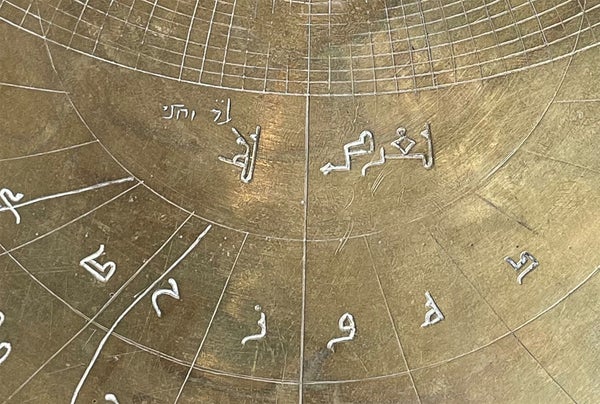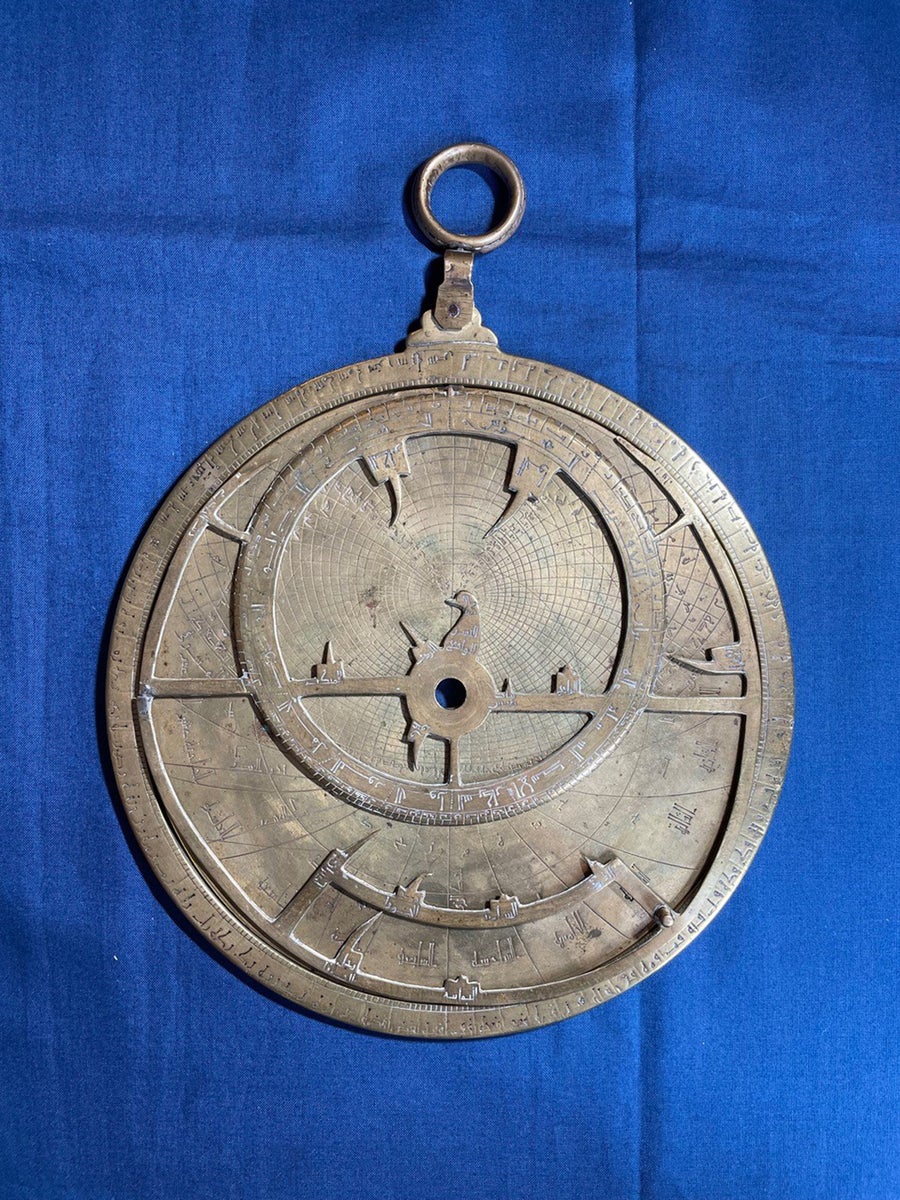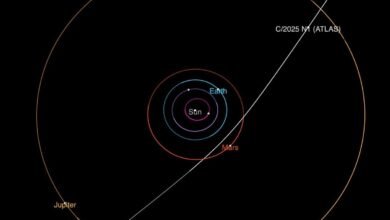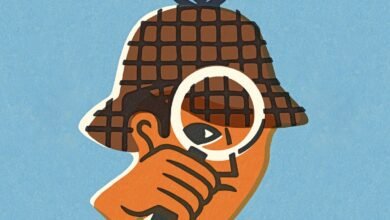How a Rare Islamic Astrolabe Helped Muslims, Jews and Christians Tell Time and Read Horoscopes

How a Rare Islamic Astrolabe Helped Muslims, Jews and Christians Tell Time and Read Horoscopes
A rare Islamic astrolabe discovered in Verona, Italy, reveals how the instrument passed through different countries and cultures

A close-up of the Verona astrolabe shows Hebrew inscribed (top left) above Arabic inscriptions.
The stars that twinkled over medieval Verona have long been known for tragically entangling two young lovers in Shakespeare’sRomeo and Juliet. Now a rare Islamic astrolabe that was recently rediscovered in that Italian city tells an equally riveting story about real stargazers who looked up at those skies.
The circular astrolabe, which is about 19 centimeters across, is particularly remarkable for the multilingual annotations etched directly into its brass surface, revealing the instrument’s journey from Muslim-ruled 11th-century Spain to an Enlightenment-era nobleman’s collection of curiosities. Over its roughly 1,000-year history, the device helped its users tell time and determine cardinal directions from the stars, as well as read their horoscopes.
“It is quintessentially beautiful that you can just handle all these layers of history and science in such a small object,” says University of Cambridge historian Federica Gigante, who found the object last summer in the private collection of 17th-century Veronese nobleman Ludovico Moscardo.
On supporting science journalism
If you’re enjoying this article, consider supporting our award-winning journalism by subscribing. By purchasing a subscription you are helping to ensure the future of impactful stories about the discoveries and ideas shaping our world today.
Astrolabes like this one are made up of rotating parts that depict a two-dimensional model of the heavens. Etched into the thin disk called a plate are two sets of concentric circles. One set is a stereographic projection of Earth, with the North Pole at the center. The circles radiating from the pole indicate specific latitudes, moving outward from the Tropic of Cancer to the equator to the Tropic of Capricorn at the plate’s rim.

The other set of circles re-creates the dome of the sky as seen from one specific latitude that is indicated on the plate. Like your eyes traveling from a star that is directly overhead to one that is just kissing the horizon, the central circle marks the highest point in the sky from that position (90 degrees), while the outermost circle is the visible horizon (zero degrees).
A sighting ruler on the back of the astrolabe allows the user to measure the angle of any celestial body in the sky. Once they know the star’s position, they can rotate the astrolabe’s star map (called the “rete”) until their star is aligned with the correct altitude angle on the plate. A line from the center of the astrolabe through the day’s date (indicated by a zodiac calendar on the rete) points to markings along the rim of the astrolabe that illustrate the time.
When examining the Verona astrolabe, Gigante found that the original markings, such as the star names and geographic coordinates, were made in Arabic. She also noticed several additions (and a deletion) made in different handwriting than that of the original maker. An Arabic inscription dedicates the instrument to someone named Isḥāq (an Arabic variant of “Isaac”)—but another word next to that name appears to have been intentionallysmudged out. This may have been a patronymic that was perhaps erased by another Isḥāq, Gigante suggests.
She also noticed that someone had etched Hebrew translations of the zodiac months just above the Arabic names. Elsewhere on the astrolabe, another individual’s Hebrew inscription makes a slight adjustment to the Arabic latitude markings. Further inspection revealed other latitude adjustments written in Western numerals, likely by a Christian Italian user.
“It shows how the material culture of science is exchanged between different communities,” says Robert Morrison, a historian of Islamic science at Bowdoin College, who was not involved with the research. “Clearly, whoever etched in the Hebrew knew how an astrolabe worked,” Morrison says, as did the person who etched the Western characters.
Gigante thinks the astrolabe was created in Al-Andalus, then a Muslim-ruled region of the Iberian Peninsula. By the time the Hebrew markings appeared, she thinks, the astrolabe had already moved to Italy, where Jews would have written in Hebrew. Between 1656 and 1672, the astrolabe likely landed in Moscardo’s collection, Gigante suspects. The astrolabe, along with other items inherited by Moscardo’s descendants upon his death in 1681, resides in what is now the Museum of the Miniscalchi-Erizzo Foundation in Verona, which is where Gigante discovered the device.
The astrolabe’s ability to tell the time during day or night made it an important part of medieval worship, Morrison says. This was especially true for Muslims, who—in addition to praying at specific times during the day—also needed to pray facing the specific direction of a sacred building in Mecca called the Kaaba.
The astrolabe was also essential for something that seemed to transcend all three Abrahamic religions: astrology. “People used it as a way to understand their relationship with the cosmos,” Morrison says, and they did so in a way that complemented (rather than competed with) religious beliefs.
Astrology was an integral part of society in the Middle Ages, says Josefina Rodríguez-Arribas, a science historian at the Polish Academy of Sciences, who provided guidance for the new study but was not directly involved in the work. At the time, horoscopes would have guided political, economic and medical decision-making.
Though modern audiences might see the astrolabe as a sophisticated scientific instrument, Rodríguez-Arribas says the careful observations and calculations the astrolabe enabled were generally not done in the name of basic research. “There was always a practical purpose,” she says. And oftentimes that purpose was casting horoscopes.
But as time went on, “the whole picture of the world changed with Copernicus and Galileo and Kepler,” Rodríguez-Arribas says. The scientific revolution altered both the shape of the universe and the way people went about questioning it. As horoscope casting gave way to hypothesis testing, the astrolabe was replaced by instruments that better served the scientific needs of astronomers.
Gigante published her findings this month in the journal Nuncius.




